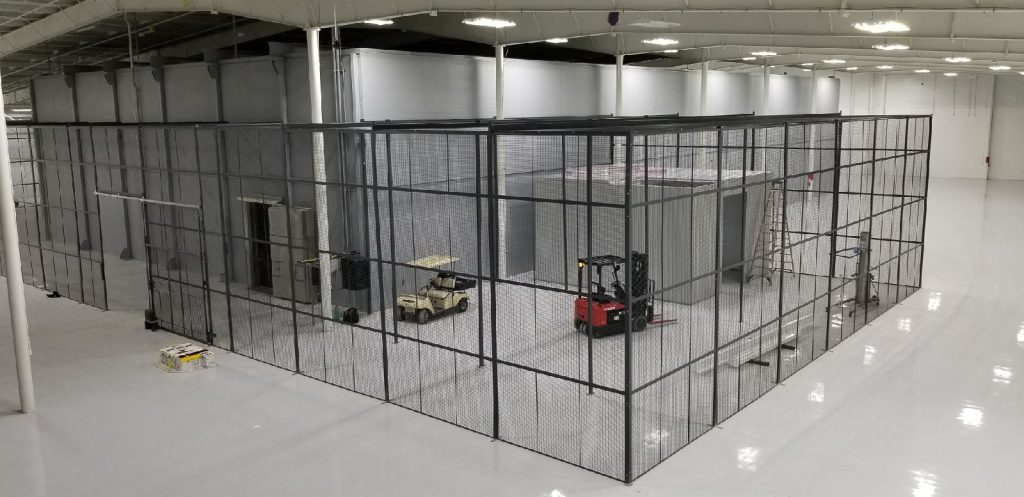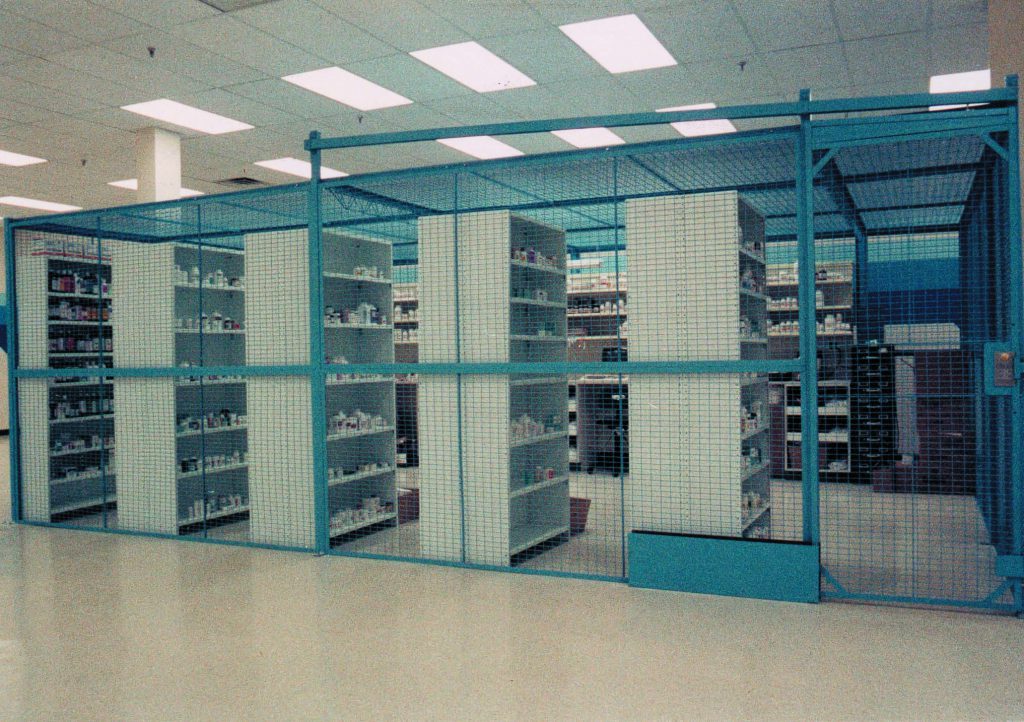Meeting the DEA Requirements for Storage
"Controlled substances" are those that are regulated by the Drug Enforcement Administration (DEA). While most attention is paid to illegal drugs such as heroin or cocaine, the DEA is also intimately involved with regulating the distribution of legitimate, medically necessary drugs. Over the years, the DEA has established a system of monitoring the following:
- The prescribing and dispensing of these drugs
- Their manufacturing
- The raw materials for their production
- How the finished products are stored and transported.

For manufacturers, distributors, and those who store or transport these drugs, the DEA has specific mandates for warehouses or storage rooms. Generally speaking, Class III, IV, and V controlled substances require a wire cage with limited access. On the other hand, Class I and II drugs, require a solid-walled vault, also with limited access. DEA specifications allow for multiple uses of vaults and cages, covering, for example, both storage of outgoing product and incoming returns or reject materials. Manufacturers can decide to store both finished goods and bulk raw materials, some of which are also regulated as controlled substances. Therein lies a common regulatory/business problem: how to design and operate commercially necessary facilities, while meeting these strict regulatory requirements.
CustomVault (Bethel, CT) and WireCrafters LLC. (Louisville, KY) are two leading suppliers of secured-storage materials, engineering and construction services. This article explains the details of DEA approved storage cages and vaults, and the operational considerations that go into this compliance.
DEA Controlled Substance Storage Requirements
The relevant DEA requirements for controlled substances storage are found in 21 CFR 1301.72.
In summary form, they mandate:
- Walls of the vault and ceilings of reinforced concrete or "substantial" masonry.
- Vault doors and frames providing 30 "man minutes" against surreptitious entry, up to 20 "man hours" against lock manipulation.
- Vault doors outfitted with day gates that are self-closing and self-locking.
- Alarms, and monitoring devices such as sound accumulators or ultrasonics.
- Cages with walls of not less than No. 10 gauge steel fabric, mounted on steel posts set in concrete or installed with pinned or brazed lab bolts; with mesh openings not more than 2.5 in.
- Cage ceilings with similar contraction (lighter gauge steel mesh in some situations), or cages that are secured to the ceiling of the storage facility.
- Self-closing and self-locking doors for cages; alternatively, for occasional access to the cage, a 24-hour/day monitoring service.
Another set of relevant regulations originates from the General Services Administration (GSA) of the federal government: these specify "TR/TL" (torch and tool) ratings that measure how resistant the panels are to forced entry. 
Modularity Enhances Flexibility
Manufacturers and distributors with warehouses need to be able to handle capacity changes as new drugs are approved, distribution patterns change, or warehouse floor space is reconfigured. WireCrafters provides standard wall panels with a maximum length of 10 ft., and are made of 2 x 1-in. opening 10 gauge steel wire mesh (Fig. 1, left). The panel frames satisfy the requirement for horizontal reinforcement every 60 in. CustomVault offers both MegaVault™ panel systems utilizing precast concrete; and LightWeight™ panel systems composed of aggregate in thicknesses of 4 to 17 in., spanning lengths up to 30 ft. These modular panels are positioned and secured within a heavy-duty steel framework. Alternatively, preconfigured cages or vaults like CustomVault's MPB™ can be supplied with preset door and locking mechanisms, interior racks, and ventilation and alarm systems. The MicroVault™ is a step-in, modular vault suitable for smaller volumes or laboratory settings. Minimum capacity is 93 cu. ft.
A common practice is to design a vault for Class I and II controlled substances within a larger cage where Class III, IV, and V drugs are stored. This has the advantage of shared utilities and security systems.
Secure Ceilings
The DEA also specifies rules pertaining to the ceilings of the cages or vaults, allowing either for ceilings constructed along the same lines as walls, or to have the vault or cage be built flush with the ceiling of the warehouse itself. CustomVault recently had an application where a 57 x 43 x 29-ft-high WireCrafters cage was required for the Schedule III, IV, and V substances. In addition, a vault was required for Schedule I and II substances. The vault was situated within the parameters of the cage, so the cage was designed to go up and over the vault for added value and security.
Optimizing Limited Space
The current trend in the pharmaceutical industry is to "go high" in response to limited distribution/warehouse space (Fig. 2, right). This limits the vault footprint and takes advantage of existing warehouse elevations. CustomVault led this 'up not out' movement by creating its HighBay™ vault solution, which can top out at 40 ft. inside clear elevation; and accommodates any rack configuration, typically six levels high. Double-leaf vault doors accommodate resulting traffic patterns.
Quite often tall cages, 15 or more feet high, require cutouts for overhead beams and joists. In these instances, WireCrafters can make panels with cutouts to fit around these obstructions. Or, based on the installer's preference, the uppermost wall panel can be supplied in a way where cutouts can be made during installation. Either method provides the end user with a professionally finished secure enclosure. In designing these high-elevation structures, care must be given to how forklifts or pallet jacks will interact with the storage racks and driving lanes. Doors must also allow for vehicle entrance and exit.
Other operational considerations for managing controlled substance storage and distribution involve worker certification and training, passing DEA design and operational reviews, and specifying monitoring systems and services. In the final analysis, a good cage/vault design will provide the necessary protection, while factoring in the operating costs and efficiencies of the space available, and the inbound and outbound material handling practices.
To learn more about our DEA Drug Storage Cages or get a quote, please click the image below.
